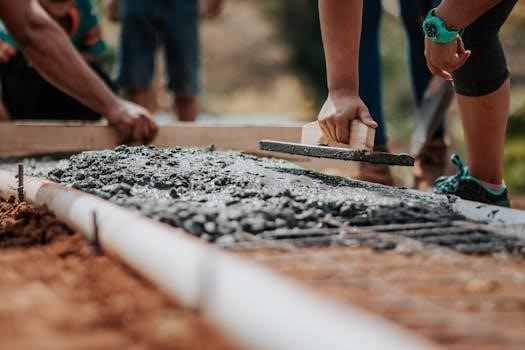gaggia anima manual

gaggia anima manual
Gaggia Anima Manual⁚ Comprehensive Guide
Welcome to the comprehensive guide for your Gaggia Anima! This manual provides essential information for setup, operation, and maintenance, ensuring optimal performance. Learn how to troubleshoot common issues, understand error codes, and perform regular cleaning. Maximize your coffee experience with our detailed instructions and expert tips for the Gaggia Anima.
The Gaggia Anima is a super-automatic espresso machine designed to bring the café experience to your home. Known for its user-friendly interface and efficient brewing capabilities, the Anima simplifies the process of making espresso, coffee, and milk-based beverages. This machine combines Italian design with modern technology, offering a seamless experience from grinding to dispensing.

With features like a ceramic grinder, programmable settings, and an automatic cleaning cycle, the Gaggia Anima is built for convenience and longevity. Whether you are a beginner or an experienced coffee enthusiast, the Anima provides consistent results and allows for customization to suit your preferences. Its compact design makes it a great addition to any kitchen, while its robust functionality ensures a satisfying coffee experience every time.
This guide will walk you through every aspect of the Gaggia Anima, from initial setup to advanced troubleshooting, ensuring you get the most out of your machine. We will cover everything from understanding the control panel to mastering milk frothing techniques, so you can enjoy café-quality beverages at home.
Initial Setup and Use
Before you can enjoy your first cup of coffee with the Gaggia Anima, it’s essential to follow the initial setup steps carefully. Begin by unpacking all components and placing the machine on a stable, level surface. Ensure there is enough space around the machine for ventilation and easy access to the water tank and bean hopper.
Next, rinse the water tank thoroughly and fill it with fresh, filtered water up to the maximum level. Place the tank securely into the machine. Open the bean hopper lid and add your favorite coffee beans, making sure not to overfill. Now, plug in the machine and turn it on using the power button.
The Gaggia Anima will prompt you to set the language and water hardness level. Follow the on-screen instructions to complete these settings. It is crucial to set the water hardness correctly to ensure proper descaling intervals. Once these settings are configured, the machine will perform an initial rinse cycle. Allow the rinse cycle to complete before brewing your first beverage. Your Gaggia Anima is now ready for use, offering a delightful coffee experience.
Understanding the Control Panel and Settings
The Gaggia Anima features an intuitive control panel designed for ease of use. Familiarizing yourself with the various buttons and settings will enhance your coffee brewing experience. The main interface typically includes buttons for selecting espresso, lungo, and other specialty drinks, along with options to adjust coffee strength and volume.
Navigating the menu allows you to customize settings such as water hardness, temperature, and pre-infusion. The water hardness setting is crucial for accurate descaling alerts. Adjusting the temperature can fine-tune the flavor of your coffee, while pre-infusion enhances aroma extraction. The control panel also displays maintenance alerts, such as reminders to empty the coffee grounds container or refill the water tank.
Understanding these alerts ensures your machine operates smoothly. Error messages may also appear on the display, indicating specific issues that require attention. Consulting the troubleshooting section of this manual will help you resolve these errors. By mastering the control panel, you can tailor your Gaggia Anima to your preferences and maintain its optimal performance.
Brewing Coffee⁚ Step-by-Step Instructions
Brewing the perfect cup of coffee with your Gaggia Anima involves a few simple steps. First, ensure the machine is powered on and the water tank is adequately filled. Also, check that the bean hopper contains fresh coffee beans. Select your desired coffee strength and volume using the control panel buttons. For a standard espresso, press the espresso button; for a longer coffee, select the lungo option.
Place your cup under the coffee dispensing spout. Before starting the brewing process, you may want to preheat your cup with hot water from the machine to maintain the coffee’s temperature. Press the start button to begin brewing. The Gaggia Anima will grind the beans, pre-infuse the coffee grounds, and then extract the coffee into your cup.
Once the brewing is complete, the machine will automatically stop. Remove your cup and enjoy your freshly brewed coffee. Regularly empty the coffee grounds container and clean the drip tray to maintain the machine’s hygiene and performance. Adjusting the grind settings can also fine-tune the coffee’s taste to your preference.
Milk Frothing Techniques
Mastering milk frothing with your Gaggia Anima opens a world of delicious coffee beverages. Start by selecting cold milk – ideally whole milk – for the best results. Pour the milk into a stainless steel frothing pitcher, filling it to about one-third full to allow room for expansion; Next, activate the steam wand by pressing the steam button on the control panel.
Purge the steam wand by briefly opening the steam valve to release any condensed water. Insert the steam wand tip just below the surface of the milk at a slight angle. Open the steam valve gradually to introduce air into the milk, creating a swirling vortex. Lower the pitcher as the milk volume increases, keeping the wand tip near the surface to continue incorporating air.
Once you’ve achieved the desired amount of foam, submerge the wand deeper into the milk to heat it thoroughly. Close the steam valve before removing the pitcher. Gently swirl the milk to integrate the foam and tap the pitcher on the counter to release any large bubbles. Pour the frothed milk over your espresso to create lattes, cappuccinos, and other specialty drinks. Remember to clean the steam wand immediately after use to prevent milk buildup.
Cleaning and Maintenance Procedures
Regular cleaning and maintenance are crucial for ensuring the longevity and optimal performance of your Gaggia Anima. Start by emptying the drip tray and coffee grounds container daily to prevent overflow and buildup. Rinse these components thoroughly with warm water and mild detergent, ensuring they are completely dry before reassembling.
The brew group should be removed and cleaned at least once a week. Rinse it under running water to remove coffee residue, and use a brush to clean hard-to-reach areas. Lubricate the brew unit o-ring with Gaggia food-safe lubricant or petroleum gel, such as Vaseline, if you hear a squeaking sound during brewing or rinsing. This helps maintain smooth operation.
Wipe down the exterior of the machine with a damp cloth to keep it clean. Periodically clean the milk frothing wand by purging it with steam after each use and disassembling and soaking it in warm, soapy water. Descale the machine every two months, or more frequently if you use hard water, to prevent mineral buildup. These simple steps will keep your Gaggia Anima in top condition.

Descaling the Gaggia Anima
Descaling is a vital maintenance procedure for your Gaggia Anima, ensuring its longevity and consistent performance. Mineral buildup from water can clog internal components, affecting brewing quality and potentially causing damage. Gaggia spa recommends descaling at least every two months, especially if you don’t use a water softener;
Begin by using a Gaggia descaling solution, following the instructions on the bottle. Typically, you’ll mix the solution with water in the water tank. Initiate the descaling program through the machine’s menu. The Anima will run the solution through its system, dissolving mineral deposits. This process may take around 30-45 minutes.
After descaling, thoroughly rinse the water tank and run several cycles of fresh water through the machine to remove any remaining descaling solution. Ensure the machine is descaled properly to remove any lingering tastes or odors. Regular descaling prevents issues and maintains the quality of your espresso.
Troubleshooting Common Issues⁚ Error Codes (E01, E02, E03, E04, E05, E10, E11, E14, E15, E22)
Understanding error codes is crucial for maintaining your Gaggia Anima. E01 and E02 often relate to grinder issues, such as no beans or a clogged grinder. E03, E04, and E05 indicate general malfunctions. For E01, ensure the bean hopper isn’t empty. For E02, clear any obstructions in the grinder, following cleaning instructions.
If you encounter E10, E11, E14, or E22, the machine requires professional service. These codes typically indicate more complex internal problems. Submit a support request for repair.
Other common solutions include turning the machine off and on again, checking the water tank’s position, and ensuring the brew group is correctly inserted. If issues persist, consult the user manual or contact customer support. Addressing error codes promptly prevents further damage and ensures your Gaggia Anima operates smoothly.
Addressing Grinder Problems (Clogged Grinder)

A clogged grinder is a common issue with the Gaggia Anima. If your machine grinds beans but no water comes out, or if you encounter error codes related to grinding, a clog is likely the culprit. To resolve this, first, turn off the machine and unplug it. Access the grinder by following the step-by-step instructions in your manual or online tutorials.
Carefully remove any visible coffee bean fragments or grounds obstructing the grinder burrs. A small brush or vacuum can help with this process. Ensure the bean hopper is empty during cleaning to prevent further blockages. After cleaning, reassemble the grinder components correctly.

If the issue persists, consider the type of beans you’re using. Oily beans are more prone to causing clogs. Switching to drier beans or using a water softener can reduce the frequency of grinder problems. If these steps don’t resolve the clog, professional servicing may be required.
Solving Water Flow Issues
Water flow problems in your Gaggia Anima can manifest as weak coffee, no water dispensing, or unusual noises during brewing. First, ensure the water tank is correctly positioned and filled to the maximum level. Remove the tank, clean the seat, and reinsert it firmly to eliminate air pockets. If the machine displays a “ventilate” error, use the programming menu to prime or ventilate the system.
Next, check for blockages in the water circuit. Descaling the machine regularly, every two months or as indicated, prevents mineral buildup that restricts water flow. If descaling doesn’t resolve the issue, inspect the brew unit for clogs. Remove and rinse the brew unit under running water, ensuring no coffee grounds obstruct the flow paths.
For persistent problems, consider using filtered or softened water to minimize mineral deposits. If water flow remains insufficient after these steps, professional service might be necessary to address internal pump or valve issues.
Lubricating the Brew Unit
Maintaining the Gaggia Anima’s brew unit is essential for smooth operation and longevity. Lubrication prevents wear and tear, ensuring consistent performance. If you hear squeaking sounds during brewing or rinsing, it’s a clear indicator that the brew unit requires lubrication. Regularly lubricating the brew unit’s O-rings will ensure a better seal.
To lubricate the brew unit, first, remove it from the machine. Rinse it thoroughly with lukewarm water to remove any coffee residue. Allow the unit to dry completely. Apply a thin layer of food-safe lubricant, such as Gaggia Food-Safe Lubricant or petroleum gel (Vaseline), to the O-rings and sliding surfaces.
Ensure even distribution of the lubricant, avoiding excessive amounts that could attract coffee grounds. Reinstall the brew unit securely back into the machine. Regular lubrication, ideally every few months or after deep cleaning, will prolong the brew unit’s lifespan and maintain optimal coffee extraction.
Accessing Test Mode for Diagnostics
The Gaggia Anima features a test mode that allows users to diagnose potential issues and assess the functionality of various components. Accessing this mode can help identify problems before they escalate, ensuring timely maintenance and repairs. The test mode allows you to check grinder functionality.
To enter the test mode, specific button combinations or sequences must be followed, which can be found in the service manual. Once in test mode, you can cycle through different diagnostic tests, such as checking the pump, heating element, and sensors. Each test provides valuable information about the component’s status and performance.
The service manual is available online. It’s crucial to consult the manual for detailed instructions on accessing and navigating the test mode. This mode is especially useful for troubleshooting issues like water flow problems, grinder malfunctions, or heating failures. Use caution and follow instructions carefully to prevent unintended changes to the machine settings.
Warranty and Support Information
Your Gaggia Anima comes with a warranty that covers manufacturing defects and malfunctions under normal use. The warranty period typically lasts for a specified duration, usually one to two years, starting from the date of purchase. To ensure your warranty remains valid, it’s essential to register your machine with Gaggia shortly after purchase.
During the warranty period, Gaggia will repair or replace any defective parts or components free of charge, provided the machine is used according to the user manual’s instructions. The warranty does not cover damage caused by misuse, neglect, improper maintenance, or unauthorized repairs.
For support, Gaggia offers several resources, including a comprehensive online knowledge base, FAQs, and troubleshooting guides. You can also contact Gaggia’s customer support team via phone, email, or live chat for assistance with technical issues, maintenance questions, or warranty claims. Be sure to have your machine’s model number and purchase date ready when contacting support to expedite the process.